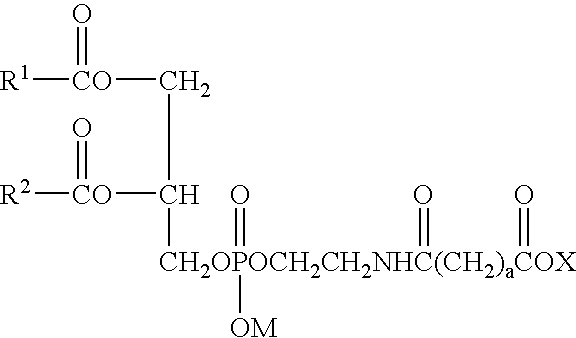Phospholipid derivatives and process for the production there
a technology of phospholipid derivatives and polyglycerin, which is applied in the direction of phosphorous compound active ingredients, group 5/15 element organic compounds, drug compositions, etc., can solve the problems of res, no work has been known so far that successfully provides microparticle drugs, and no compound has been known so far that is safe for living bodies, etc., to achieve convenient production, reduce the effect of reactivity and large viscosity of polyglycerin
- Summary
- Abstract
- Description
- Claims
- Application Information
AI Technical Summary
Benefits of technology
Problems solved by technology
Method used
Image
Examples
synthesis example 1
[0066] (1) Preparation of Distearoylphosphatidylethanolamine Succinate
[0067] Distearoylphosphatidylethanolamine (20.0 g, 26.7 mmol) was added with 150 mL of chloroform, stirred at 55° C., and added with 2.2 g (267 mmol) of sodium acetate to obtain a phospholipid solution in chloroform. The solution was added with 3.5 g (34.8 mmol) of succinic anhydride and reacted at 55° C. for 3 hours. Completion of the reaction was confirmed by thin layer chromatography (TLC) utilizing a silica gel plate where no distearoylphosphatidylethanolamine was detected by ninhydrin coloration. As the developing solvent, a mixed solvent of chloroform and methanol at a volume ratio of 85:15 was used. After the reaction, the solution was filtered to remove sodium acetate, and then the filtrate was concentrated. After the concentration of the filtrate, the residue was added with isopropyl alcohol (100 mL), and stirred at room temperature for 30 minutes. The crystals were collected by filtration, then washed ...
synthesis example 2
[0068] (2) Preparation of Distearoylphosphatidylethanolamine Glutarate
[0069] Distearoylphosphatidylethanolamine (20.0 g, 26.7 mmol) was added with 150 mL of chloroform, stirred at 55° C., and added with 2.2 g (267 mmol) of sodium acetate to obtain a phospholipid solution in chloroform. The solution was added with 4.0 g (34.8 mmol) of glutaric anhydride and reacted at 55° C. for 3 hours. Completion of the reaction was confirmed by TLC in the same manner as described above. After the reaction, the solution was filtered to remove sodium acetate, and then the filtrate was concentrated. After the concentration of the filtrate, the residue was added with isopropyl alcohol (100 mL), and stirred at room temperature for 30 minutes. The crystals were collected by filtration, washed with hexane (80 mL), collected by filtration, and dried to obtain crystals of distearoylphosphatidylethanolamine glutarate (19.8 g).
example 1
[0070] (3) Preparation of Hexaglycerol Glutaryl Distearoylphosphatidylethanolamine
[0071] Distearoylphosphatidylethanolamine glutarate (4.3 g, 5.0 mmol) was added with chloroform (25 mL) and stirred at 45° C. The chloroform solution was added with 11.6 g (25 mmol) of hexaglycerin dissolved in dimethyl sulfoxide (10 mL), and then added with 2.1 g (10 mmol) of dicyclohexylcarbodiimide and 0.6 g (5.3 mmol) of dimethylaminopyridine. The reaction was performed at 45° C. for 2 hours. Completion of the reaction was confirmed by TLC, namely, confirmed by thin layer chromatography (TLC) utilizing a silica gel plate where no distearoylphosphatidylethanolamine glutarate was detected. As the developing solvent, a mixed solvent of chloroform, methanol and water at a volume ratio of 65:25:4 was used. After the completion of the reaction, the deposited dicyclohexylurea was removed by filtration, and then the filtrate was passed through a cation exchange resin (DIAION SK1BH) filled in a column. Th...
PUM
| Property | Measurement | Unit |
|---|---|---|
| temperature | aaaaa | aaaaa |
| temperature | aaaaa | aaaaa |
| temperature | aaaaa | aaaaa |
Abstract
Description
Claims
Application Information
 Login to View More
Login to View More - R&D
- Intellectual Property
- Life Sciences
- Materials
- Tech Scout
- Unparalleled Data Quality
- Higher Quality Content
- 60% Fewer Hallucinations
Browse by: Latest US Patents, China's latest patents, Technical Efficacy Thesaurus, Application Domain, Technology Topic, Popular Technical Reports.
© 2025 PatSnap. All rights reserved.Legal|Privacy policy|Modern Slavery Act Transparency Statement|Sitemap|About US| Contact US: help@patsnap.com



